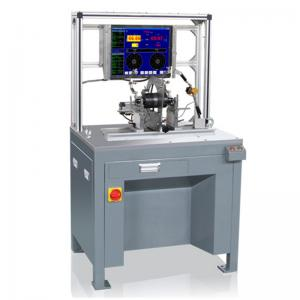The structure of the dynamic balancing machine is divided into three parts: mechanical, electrical measurement, and electrical control:
1. Mechanical part: The mechanical part is also known as the mechanical bridge. Taking a horizontal dynamic balancing machine as an example, the lower bed of the balancing machine mainly houses the various components and stabilizing equipment of the balancing machine. It can be said that the lower part is a foundation, and the rotor is supported by the left and right swing frames through rollers or V-shaped frames, providing a prerequisite for the working rotation of the rotor. By dragging the rotation of the rotor through a belt or coupling, the sensors installed on the two swing frames are converted into electrical signals and transmitted to the electrical measurement section, thereby coordinating the work.
2. Electrical measurement part: Electrical measurement, also known as electrical measurement system, is mainly used to process electrical signals transmitted by sensors and display the position and size of the rotor unbalance. Coordinate the work of the mechanical part. At the same time, the electrical measurement part is also a key component in the balancing machine, and the quality of this part can be said to directly affect the performance of the balancing machine.
3. Electric control part: The main function is to control the start and stop of drag clicks, and timely speed regulation, also known as the electric control part box. The electrical control part can be divided into DC and AC control, and some balancing machines integrate the electrical control part and mechanical part.
1. Mechanical part: The mechanical part is also known as the mechanical bridge. Taking a horizontal dynamic balancing machine as an example, the lower bed of the balancing machine mainly houses the various components and stabilizing equipment of the balancing machine. It can be said that the lower part is a foundation, and the rotor is supported by the left and right swing frames through rollers or V-shaped frames, providing a prerequisite for the working rotation of the rotor. By dragging the rotation of the rotor through a belt or coupling, the sensors installed on the two swing frames are converted into electrical signals and transmitted to the electrical measurement section, thereby coordinating the work.
2. Electrical measurement part: Electrical measurement, also known as electrical measurement system, is mainly used to process electrical signals transmitted by sensors and display the position and size of the rotor unbalance. Coordinate the work of the mechanical part. At the same time, the electrical measurement part is also a key component in the balancing machine, and the quality of this part can be said to directly affect the performance of the balancing machine.
3. Electric control part: The main function is to control the start and stop of drag clicks, and timely speed regulation, also known as the electric control part box. The electrical control part can be divided into DC and AC control, and some balancing machines integrate the electrical control part and mechanical part.

169 browse
